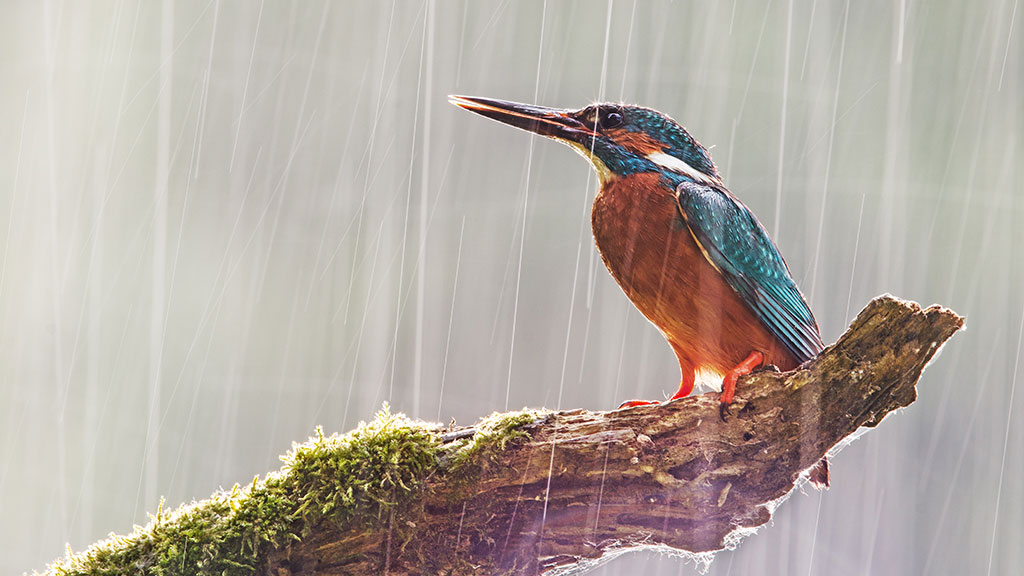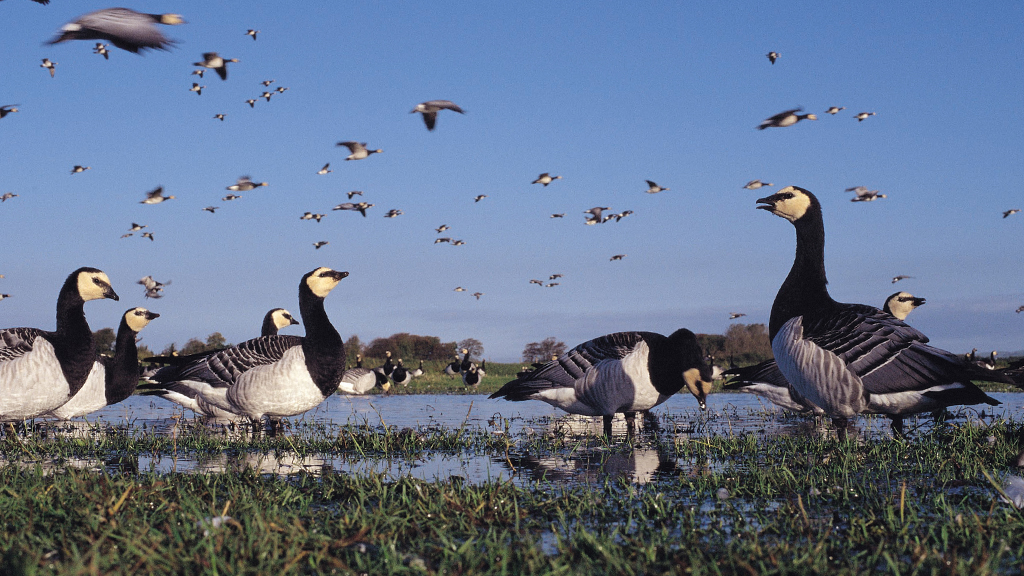Autumn stories from WWT’s wetland reserves
Our wetland reserves have seen a vibrant mix of wildlife highlights this autumn. From Caerlaverock to Arundel, each site has had its own amazements and accomplishments.
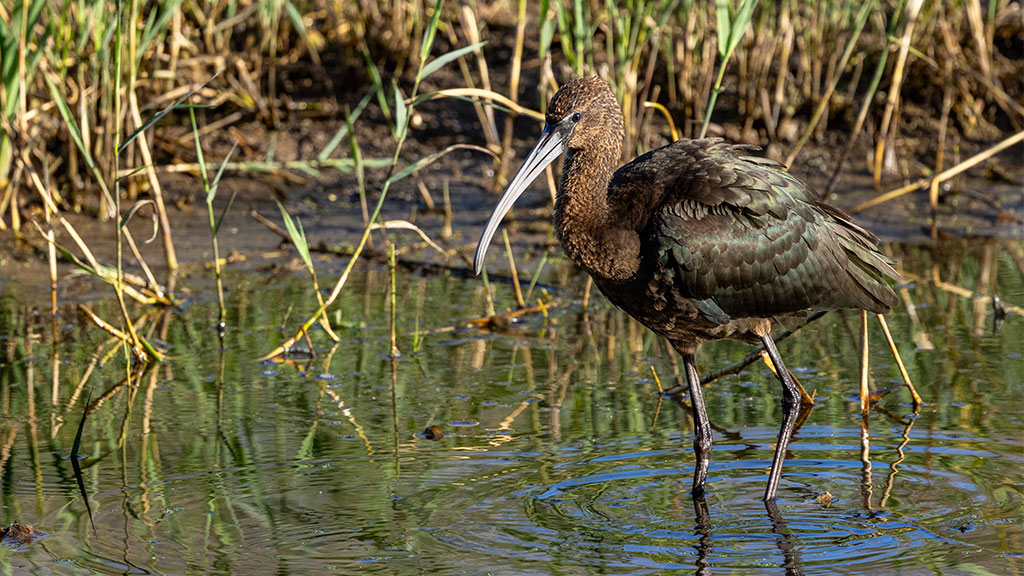
Join our Head of Reserve Management, Leigh Marshall, for a tour of the sights, sounds and stories from a busy autumn across our sites.
Let’s dive in…
WWT Castle Espie: a season of record-breaking numbers
As we all know, autumn is a time for welcoming migrant birds and Strangford Lough is no exception.
Light-bellied brent geese take centre stage at Castle Espie, with an October census across the Lough counting 30,000 birds, with around one quarter of these visiting the WWT reserve.
Another notably high count occurred with up to 50 greenshank feeding and roosting in the Wader Marsh habitat. Scaup and spotted redshank headline the list of scarcities whilst numbers of duck, waders and grebe continue to increase.
 Roosting greenshanks © Jonathan Clark
Roosting greenshanks © Jonathan Clark
We’ve been regularly surveying our little egret roost, which has reached a high of 130 individuals. We’re quite confident that this will be the highest roost count for Northern Ireland.
 Little egrets © Jonathan Clark
Little egrets © Jonathan Clark
WWT Arundel: wetland raptors and a LOT of cattle egrets
October on our reserve saw the odd flock of house martin and swallow passing through before their epic migration south of the Sahara, but we were really excited by a rather obliging osprey. Likely an adult female (showing a dark breast band), it regularly showed well, much to the delight of visiting photographers. Staying with us for over a month, this beautiful bird took advantage of the abundant food supplies on site to help fuel its migration to warmer climes for the winter.
 Female osprey © Alec Pelling
Female osprey © Alec Pelling
Boosted by another successful year of breeding, we’re counting over 100 cattle egret roosting in their usual tree in the middle of the small lagoon, visible from the Scrape Hide.
Reedbeds proving popular
Our new Reedbed viewing platform was completed mid-September and is open to visitors. Giving the feeling of being immersed in the habitat, it will allow unrestricted views of marsh harriers coming in to roost on the winter afternoons. Nine marsh harriers have been counted so far, including the family that bred on site earlier this year.
 Reedbed platform
Reedbed platform
Indeed, it’s even allowed for the far rarer hen harrier to be spotted – two were roosting on site from early November.
We’ve also been cracking on with our main habitat management works, which involves noisy machinery such as brush cutters and chainsaws, necessary to maintain habitats in suitable conditions. The benefits will be clear come the spring, when we see the fruits of our labours as the growing and breeding seasons commence.
WWT Caerlaverock: diggers, downpours and discoveries
Following a very wet September (160mm of rain) and the arrival of Storm Amy, the reserve is now well and truly living up to its wetland name.
The downpours made digger work challenging, but after nearly three months of effort, the team has delivered some fantastic habitat improvements .
Highlights include:
- Creation of new pools and channels
- Burial of the remaining crassula (invasive plant)
- Diversion and natural meandering of a previously straight stream
- Construction of leaky dams and blocking of drains
- Restoration of overgrown ponds
The newly created wetlands make more water available on site to a range of wildlife. They'll soon be being used by wintering snipe, teal and wigeon. Come the summer, we hope dragonflies and other invertebrates will colonise.
 Natterjack toadlet
Natterjack toadlet
The seasonal rain also brought some delightful surprises. Late natterjack tadpoles and toadlets were spotted, marking a decent breeding year. Even more excitingly, tadpole shrimps (triops) were recorded for the first time on the reserve since 2019. Tadpole shrimp expert Larry Griffin helped locate the first, and the team went on to find them in three more pools. Their reappearance confirms Caerlaverock to still be one of only three sites throughout the UK to host tadpole shrimps.
 Tadpole shrimp
Tadpole shrimp
Meanwhile, mild Arctic weather delayed the arrival of whooper swans and barnacle geese, but they’re now arriving in large numbers.
WWT London: star birds and record dragonfly count
In a mid-September survey, 99 migrant hawker dragonflies were counted – that’s our highest ever count. As with many dragonfly species, these insects are increasing in numbers and spreading their range northwards as our climate warms.
On the same theme, a glossy ibis that arrived mid-September is also our longest-ever staying rarity in our 25-year history. It’s still happily feeding and roosting daily on the grazing marsh, favouring newly created pools and scrapes.
 New marsh works
New marsh works
Other highlights have included a curlew sandpiper feeding on Main Lake, a long eared owl roosting in scrub around the Sheltered Lagoon and a bittern with us since mid-August. This is the third year running that we’ve had a bittern stay with us over the summer months.
 Bittern
Bittern
WWT Washington: the rain has returned!
After becoming almost completely dry in the summer, our ponds are now refilled. The amphibians will be thankful come the spring, but we’re also relieved for our new breeding species for the site – willow emerald damselfly. A pair were seen this autumn, laying eggs in the willow trees around the ponds.
 Willow emerald damselflies mating at Washington on 8th October © Ian Henderson
Willow emerald damselflies mating at Washington on 8th October © Ian Henderson
It’s also been a busy autumn for birds, with 700 curlew now using the site for roosting overnight. This is one of the largest inland roosts in the UK. Other species in good numbers have included high counts of 519 teal, 30 goosander, 4 ruff and even a wood sandpiper.
Look up!
As well as the birds stopping by, Washington is also on a key flyway for migrating geese and swans. Several flocks of pink-footed geese (up to 130 birds per flock), 30 barnacle geese and a flock of 90 whooper swans have all honked, barked and whooped their way over the site during October.
Our trusty volunteers have been hard at work getting on with reserve management. Currently they’re revamping the Saline Lagoon - completing hedge cuts, removing encroaching saplings and pulling out Typha (otherwise known as bulrush – it can take over a pond and quickly dry it out) to re-establish kingfisher pools. Fantastically, these birds have recently returned to the site after a period of absence.
WWT Llanelli: high counts and new visitors
The high autumn tides have seen our saltmarsh teeming with birdlife. A big tide can push breathtaking numbers of wading birds up into the relative safety of the saline lagoons, until a peregrine or sparrowhawk sends them into chaos.
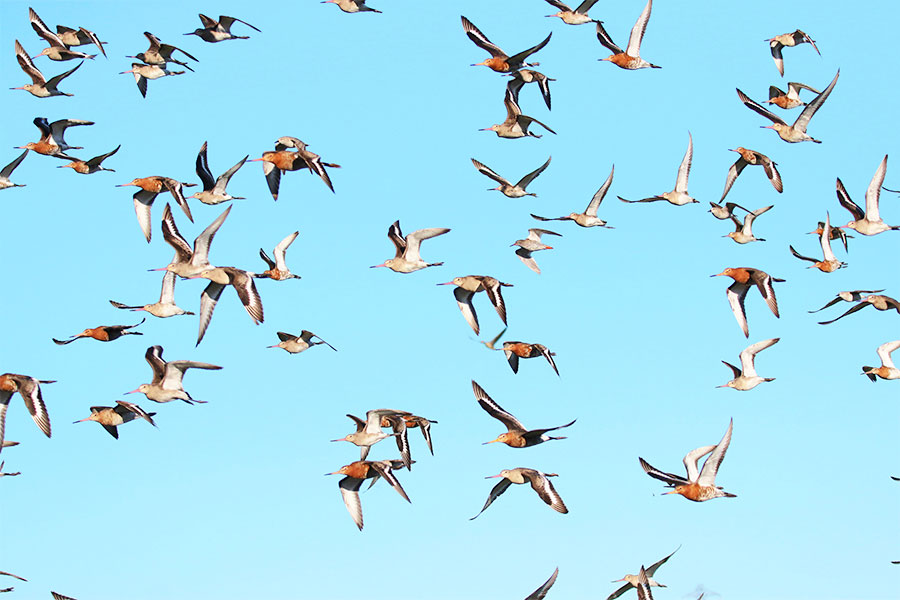 Wader flock © Rob Werran
Wader flock © Rob Werran
Just shy of our site record of 1247, we recently counted a staggering 1187 black-tailed godwit. Among the wader flocks we've had good numbers of scarcer species too, including curlew sandpipers, ruff, spotted redshank and greenshank.
Like many wetlands around the UK, this autumn saw an influx of the exotic looking glossy ibis, and we've been treated to regular views of up to 3 of them at a time. Alongside, our spoonbill flock has recently grown to 11 birds, getting closer to last year's site record of 17.
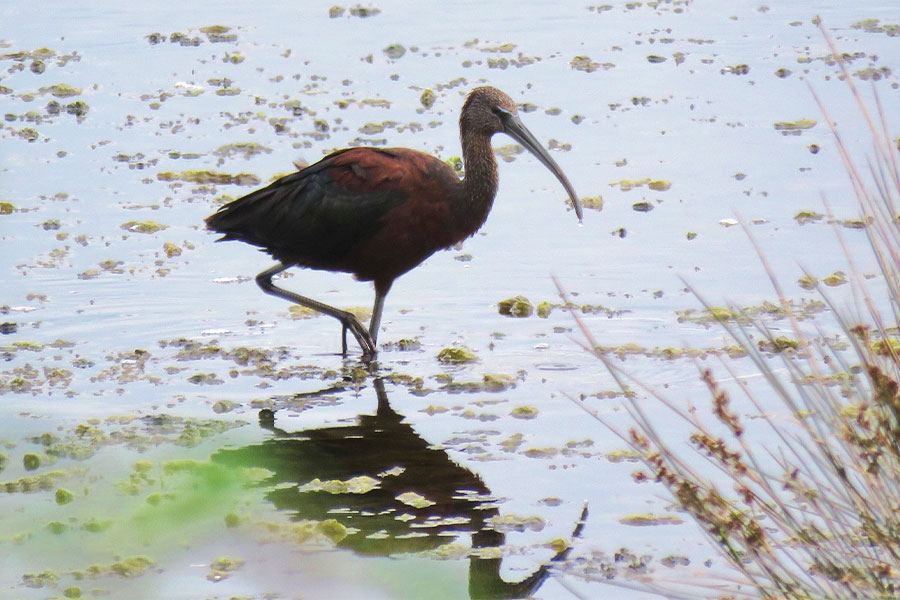 Glossy ibis © Edward O’Connor
Glossy ibis © Edward O’Connor
Another highlight has been a few visits from a female pallid harrier hunting on the marsh, and we were treated to amazing views of an osprey fishing in the Millennium Wetlands back in September.
Dragonflies linger on
The last of the dragonflies have been hunting on sunny days – with huge southern hawkers patrolling the paths and common darters basking on the Heron’s Wing Bridge. We also recorded our second ever black darter a couple of months ago.
 Black darter © David Westmacott
Black darter © David Westmacott
As the leaves turn and fall, tits form roving flocks in the canopy with goldcrests and treecreepers, and scarlet chested bullfinches feed on dried seed heads. Kingfishers fish daily in the Deep Water Lake, and as the nights draw in, large numbers of cormorants roost in the trees around the shore. We've had a great egret fishing here too. As dusk approaches we've heard the thin tzeep of redwing migrating overhead, and flitting bats on warmer evenings.
Wintering bird numbers building
Camouflaged snipe are reliably seen roosting on the stony islands by the Peter Scott Hide, and wildfowl numbers are building up with the arrival of wigeon, pintail, teal and gadwall. Further into the reserve, the reedbeds have turned from vibrant green to yellow brown, rustling in the wind, where we've recently spotted a couple of beautifully woven harvest mouse nests along the path edges.
 Common snipe © Russ Myners
Common snipe © Russ Myners
WWT Martin Mere: restored meadows and incoming geese
This year has seen great progress on restoration of our wet grassland habitat, funded by CMA. A ‘weed wiper’ has been used to treat the soft rush on site, which was dominating the fields, supressing the wildflowers and making the wet grassland less suitable for ground nesting waders.
We successfully treated 20 hectares, and can’t wait to see the benefits next year. The below photo shows the newly dead rushes in light brown, with the bright green wildflowers and grasses pushing through and flourishing.
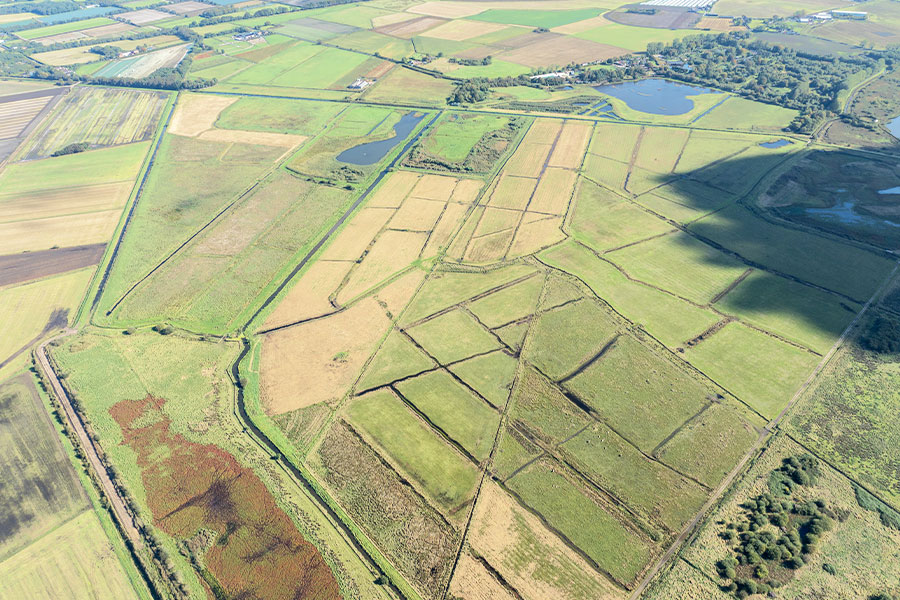 © David Buckles
© David Buckles
The sound scape of thousands of pink-footed geese landing on the pools and wet fields is the sound of autumn for us. We’ve had great numbers of them this autumn, our highest count was 11,439, but the numbers vary every day.
They use our wetlands like a service station as they migrate from their breeding grounds in Greenland and Iceland down to their wintering grounds in the UK. Most of the population winter in Norfolk but they stop off with us for either a few hours or a few days feeding up before continuing on.
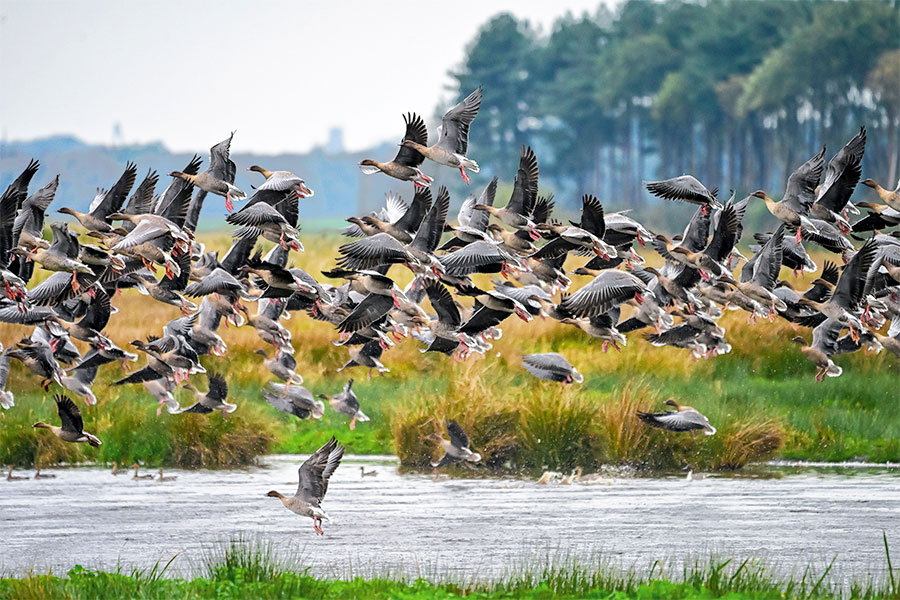 Pink-footed geese © Amy Ashley-Mather
Pink-footed geese © Amy Ashley-Mather
WWT Slimbridge: new breeding species at a birder’s paradise
Our busy schedule of autumn work has been in full-throttle, even with ongoing drought conditions, and then the November rain, hampering us somewhat.
We’ve been enhancing crane habitat by creating new ponds and deepening channels, building greater drought resilience. It’s hoped that this will benefit fish populations in the long term, too.
The warm weather brought new species to the reserve, with a stunning black-winged kite visiting us at the end of August. This was only the second ever bird to be recorded in the UK. It’s a species that is expanding its breeding range northwards as the climate warms.
Always distant whilst on the reserve, we’ve used a stock image below so as you can appreciate the beauty of these birds.
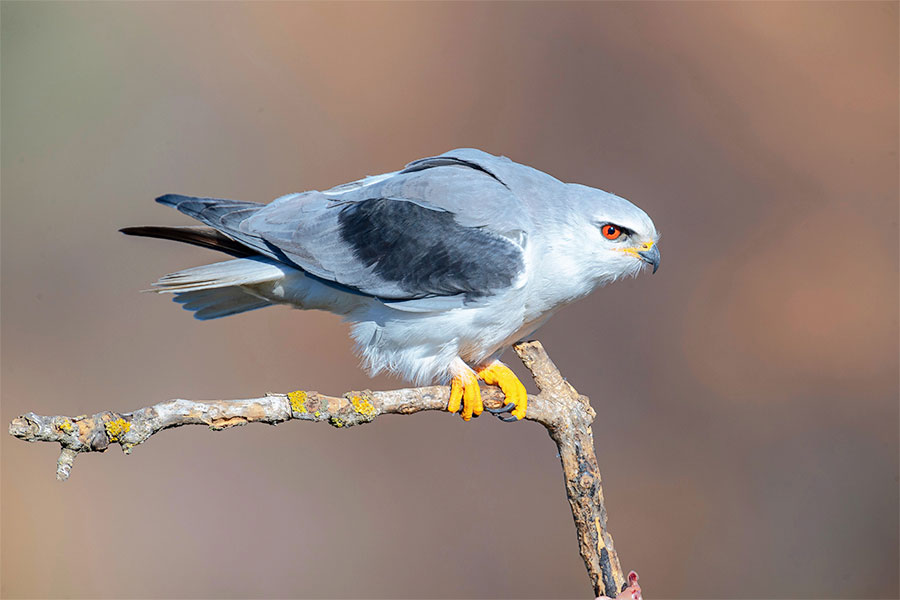 Black-winged kite © Jesus Cobaleda/Shutterstock
Black-winged kite © Jesus Cobaleda/Shutterstock
Willow emerald damselflies were proven to have bred for the first time, expanding their range across the whole reserve. At the time, these were probably the most-westerly breeding population of the species. That likely won’t be the case by next summer, as they rapidly take on new ground as the climate warms.
 Willow emerald at Slimbridge
Willow emerald at Slimbridge
Later autumn migration has brought with it a plethora of birds, including a buff-breasted sandpiper, two Temminck’s stints, two long-staying glossy ibis, three wood sandpipers, three bitterns, five spoonbills, eight little stint, 23 curlew sandpipers, 28 cranes, 40 cattle egrets, 220 avocet, and 634 ringed plover.
16th November saw the first Bewick’s swans of the season arrive.
WWT Steart Marshes
This autumn has seen us expand the freshwater scrapes on Otterhampton Marsh and the addition of two new viewing platforms, allowing for better viewing of birds using the area.
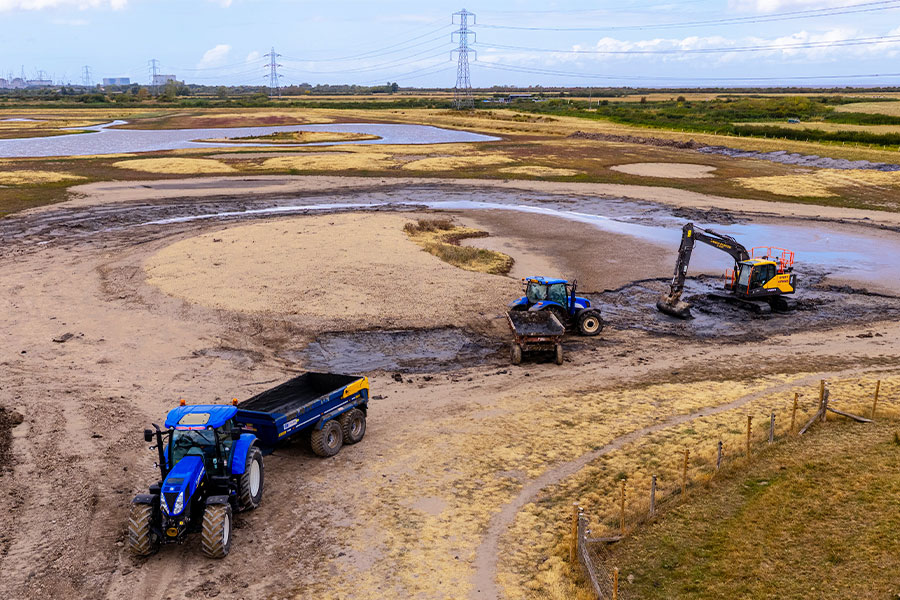 Otterhampton scrape works © Joe Beaney
Otterhampton scrape works © Joe Beaney
We’re almost there with opening up access to our saltmarsh boardwalk, allowing visitors to get up close with this incredible habitat.
 Saltmarsh boardwalk
Saltmarsh boardwalk
With winter round the corner, we will soon be getting stuck in to a long list of hedge laying and scrub maintenance work.
Mammal surveys
Volunteers have been taking part in national harvest mouse surveys this autumn, already finding quite a few nests around the reserve.
And we’ve reached a milestone with our water voles, having just completed our 10th year of surveys since the saltmarsh breach. Water voles are present across the reserve including a population in some saline ditches within the main saltmarsh.
Reserve rarities
We’ve seen a wood sandpiper and up to three spotted redshank on the reserve, a couple of grey phalaropes and a Sabine’s gull out on Bridgwater Bay. Over the saltmarsh, we’ve been treated to the first of the wintering raptors, with hen harrier, short-eared owl and merlin.
WWT Welney
Autumn on the reserve has been set against the backdrop of drought this year. East Anglia has experienced a record-breaking hot and dry year, with the driest spring and summer since 1976 and the warmest summer on record, resulting in reservoirs, rivers and groundwater levels all below normal. That means our work to maintain the reserve for the species that call it home, a challenge.
Silver linings
The dry weather has had some benefits though. Our cattle herd were able to stay on pasture into November, leaving the habitat in excellent autumn condition all ready for winter and spring birdlife. This can’t happen in wet summers, just like our scrape management work – another thing we’ve not had a problem completing this autumn.
We’re now adding water from the tidal river to create wet, splashy areas for the whooper swans and wintering wildfowl that are arriving.
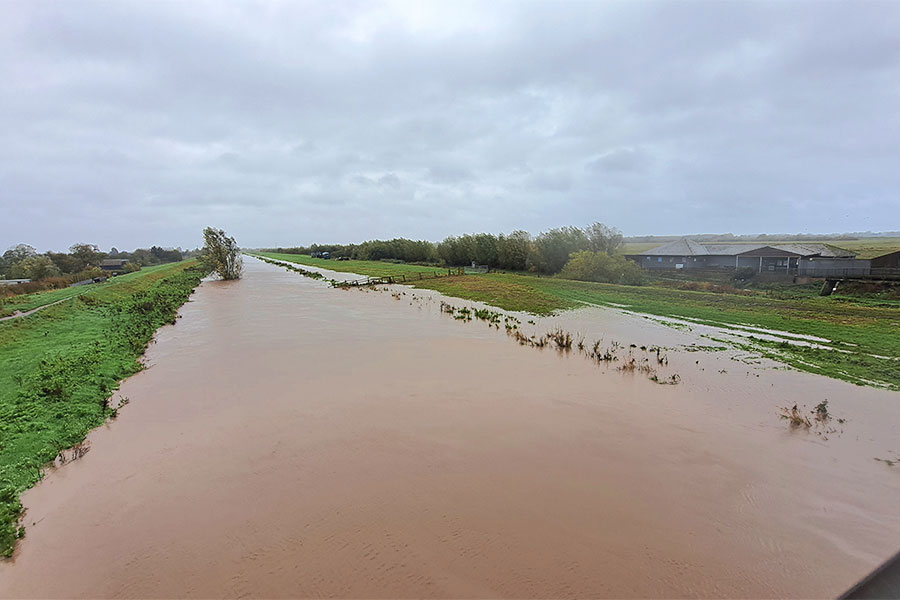 Late October spring tide at Hundred Foot Bank
Late October spring tide at Hundred Foot Bank
Hard at work
Our volunteer work parties have been busy with projects, including rebuilding a willow screen and pond dipping platform. We also hosted a couple of corporate work parties who assisted with clearing cut reeds in front of our hides.
Beetle-mania
This year we saw an increase in tansy beetles compared to the previous very wet years. However, this population remains small and vulnerable. In an effort to increase our understanding and consider conservation breeding at Welney, Sam, our Warden, visited nearby Woodwalton Fen to learn more about how they captive breed their beetles and explore some of the site.
 Tansy beetle at Welney © Kim Tarsey
Tansy beetle at Welney © Kim Tarsey
There are still quite a lot of unknowns with the tansy beetle, but we hope over the coming few years by working in partnership with other organisations we can better understand their ecological requirements to direct conservation measures appropriately.
Ibis and cranes
Like many other wetlands up and down the country, we have hosted several glossy ibis on site, though they have been quite elusive. Cranes are a regular autumn feature, and this autumn is no exception, with daily sightings of around 20. A count across the Fens reveals that there are now an incredible 100+ cranes using the Ouse Washes and surrounding landscape.
 Pink-footed goose flock © Simon Stirrup
Pink-footed goose flock © Simon Stirrup
Returning geese
Last year pink-footed geese returned to the Fens for the first time since the 1950’s and we hoped they would be back this autumn. Sure enough, almost 3,000 have again returned to the Ouse Washes, with many feeding on the beet and potato fields around us with the whooper swans.
It’s thought that this return is due to changes in sugar beet harvests further north in Norfolk, so the geese are now making use of the Fens around Welney.
September also saw an early arrival of whooper swans, with numbers steadily building. Our first co-ordinated count in mid-November recorded 8823 birds across the Ouse Washes.
Other wildlife highlights have included flocks of 150+ ruff, green-winged teal, ruddy shelduck, bittern and cattle egrets (30+). And excitingly, the first Bewick’s swans arrived at Welney on 21st November.
Ready to get your nature fix?
Each of our centres offers the most wonderful wildlife encounters. And with winter just around the corner, there’s even more for you to see.
Not a member? Book online and save time on arrival.
Find your nearest wetland siteAll species work on WWT reserves is carried out under an approved license. We continue to monitor avian influenza across our wetland sites this winter.
Header image: Glossy ibis at Slimbridge
